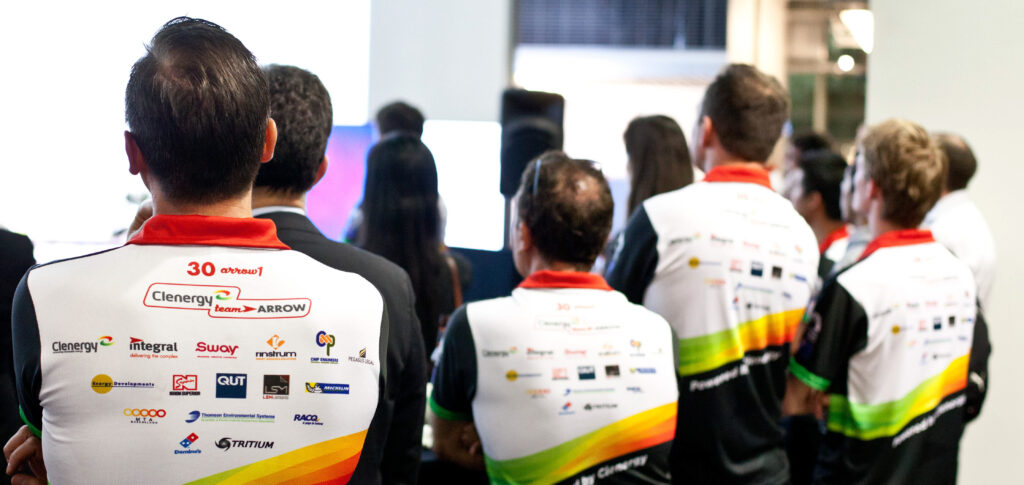Fundraising is an essential component of solar car racing and other not-for-profit organisations. A team may have the best technical design, an experienced team and a winning strategy, but without adequate funds these ideas can only ever remain on paper. Sponsorships are a key way of obtaining these funds, but how do you go about it?
This is a three part series by Anthony Prior, our team Treasurer. Feel free to ask questions in the comments!

Obtaining sponsorship is hard.
Identifying, reaching and persuading the right person in an organisation to support your team is a challenge faced by all teams. This article intends to provide fundraising strategies and approaches that, from Clenergy TeamArrow’s experience, were found to be successful when raising money from external sponsors.
Clenergy TeamArrow (CTA) is a fully independent solar car team and is entirely reliant upon external funds raised by its sponsorship arm. CTA is not a university team (although we have a close affiliation with Queensland University of Technology (QUT)) and so all money and resources needed to fund the development of the car and operation of the team are raised through sponsorship agreements.
Raising funds and resources consists of two main types:
- Cash donations – actual currency deposited into the bank which may be used for general, or specific purposes, depending upon the sponsorship agreement, and
- In-Kind donations – any type of consideration which a supporting company may provide which is not cash; such as components, parts, tools, material, technical support, space, or advice.
Both types are vitally important. When you can get the exact part/component from a sponsor, that is fantastic, but often there are elements for which you simply cannot get in-kind sponsorships and that is when raising cold-hard cash is vitally important.
YOUR STORY
Before your team can go out into the world asking for money, you must first figure out who you are as a team.
What is your brand?
Who are you? What is your team about? What makes you unique? What are your values? Why are you doing this? What is your story? Why can you be trusted with a sponsor’s money? Why should they support you?
The answers to these questions define your brand. Your brand is who you are, your teams identity, how you represent yourself to the world. It defines what makes you unique and why people should support you. Your brand will have a profound impact on what sponsors will find attractive in your team. It is important that the answers to these questions are consistent and self-reinforcing.
Your brand must be carefully defined, constructed, and defended at all costs. It is the one thing that makes you unique and that cannot be copied by other teams. A strong brand brings credibility – companies will trust you with their money, and will feel confident in associating their own brand with you.
Brands can and should change with time as your team grows. TeamArrow started out as a group of Queensland individuals and businesses who wanted to build a solar car and enter into the World Solar Challenge. We defined ourselves as a Queensland team, a bunch of battlers with grit and determination wanting to show to the world what Queenslanders could do. As such we targeted and landed iconic Queensland brands such as RACQ, QUT, Tritium, and Thiess.
Following our success in the 2013 Bridgestone World Solar Challenge and 2015 Abu Dhabi Solar Challenge, we rebranded ourselves as “Australia’s Premier Solar Car Racing Team” and expanded to key national and international sponsors, attracting a naming rights sponsor to become Clenergy TeamArrow for the Bridgestone World Solar Challenge in 2015.
WHAT IS IN FOR THEM?
The key consideration when seeking to obtain a sponsorship agreement from a potential sponsor is to not first ask what the sponsor can provide for you but:
“What is in it for them?”
It is very tempting to seek out organisations which provide the exact widget you require or who seem to be an easy target to obtain money, but it is essential to first ask what value the organisation can receive from supporting your team. Once it is clear there is value for them, benefits for your team will flow from this.
Each potential sponsor has unique requirements and so each approach must be tailored to suit. Boiler plate/form letters will be quickly identified and discarded.
Some of the benefits that a solar car team can offer to organisations may include:
- The opportunity to showcase a company’s abilities and products
- Exposure of their brand in the media
- Alignment to internal initiatives and values, or external messaging (ie Excellence, Innovation, Teamwork)
- Desire to be seen by the community as supporting green initiatives and innovation.
- Access to contacts within other businesses in the industry
- Access to the best students – the first opportunity at identifying and hiring the smartest students
- Providing their products for use by the team, so students may become early adopters of technology and use and advocate the product through their professional career
- Rights to create media or use of your images that can be used to promote their own brand and products.
Simply defining how big a sticker on the car will be for a set amount of money will not be enough (for most companies). They will require a tangible benefits that will flow from their investment. And it is an investment from which they will expect a return.
Organisations can be, and should be, acting in their own self-interest when entering into a sponsorship agreement. Keep this in mind and your approaches will be more successful.
Now you have a pitch, its time to form a Strategy!